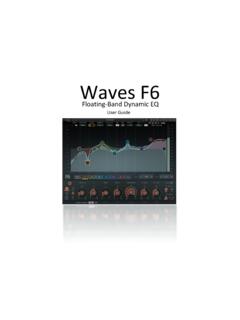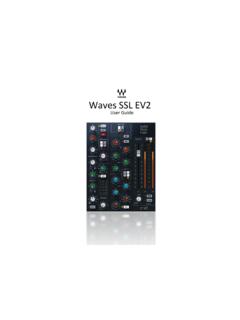Transcription of Waves VOCAL RIDER
1 Waves VOCAL RIDER . User Guide TABLE OF CONTENTS. Chapter 1 Introduction ..3. Product Overview ..3. Concepts and Components ..4. WaveSystem Chapter 2 Quickstart Guide ..5. Chapter 3 Interface and Controls ..6. Controls ..7. Waves VOCAL RIDER User Guide 2. Chapter 1 Introduction Welcome Thank you for choosing Waves ! In order to get the most out of your new Waves plugin, please take a moment to read this user guide. To install software and manage your licenses, you need to have a free Waves account. Sign up at With a Waves account you can keep track of your products, renew your Waves Update Plan, participate in bonus programs, and keep up to date with important information. We suggest that you become familiar with the Waves Support pages: support.
2 There are technical articles about installation, troubleshooting, specifications, and more. Plus, you'll find company contact information and Waves Support news. Product Overview VOCAL RIDER is the first of Waves pioneering new series of Mix tools. As its name implies, it automatically rides VOCAL track levels. Instead of manually riding a mixing console fader, or tediously drawing in every level change on a DAW track, VOCAL RIDER does it for you, making it a true timesaver. All you need to do is set the target range of the VOCAL level in relation to the rest of the mix. Then, VOCAL RIDER adjusts the level so it stays within your target, raising or lowering the VOCAL volume, in real-time. And unlike compression, VOCAL RIDER doesn't add any additional coloring to your track.
3 From the recording studio to the concert stage, from the broadcast studio to the post house, VOCAL RIDER takes mixing to the next level. Keep consistent VOCAL & dialog levels automatically. Steady VOCAL levels without affecting their sound. Achieve an open-sounding mix by avoiding over-compression. Real-Time means zero latency and no pre-scan needed. Intelligently adjusts VOCAL level based on dynamics of the music tracks. Write the automatic riding to an automation track for fine tuning. Waves VOCAL RIDER User Guide 3. Concepts and Terminology The VOCAL production process can be divided into several stages: recording, comping, mix positioning, sound character adjustment (Dynamics/EQ/Effects), and gain riding. VOCAL gain riding is the final stage, during which the VOCAL level is fine-tuned by making small changes to its playback level, to make its position in the mix consistent throughout the song.
4 VOCAL RIDER splits the elements of the mix into two main components: vocals and playback. VOCAL : All VOCAL tracks, with or without effects (as defined by the user). Music: The rest of the mix, minus the VOCAL tracks Components WaveShell technology enables us to split Waves processors into smaller plug-ins, which we call components. Having a choice of components for a particular processor gives you the flexibility to choose the configuration best suited to your material. Waves VOCAL RIDER includes four components: VOCAL RIDER Mono VOCAL RIDER Stereo VOCAL RIDER Live Mono VOCAL RIDER Live Stereo WaveSystem Toolbar Use the bar at the top of the plugin to save and load presets, compare settings, undo and redo steps, and resize the plugin. To learn more, click the icon at the upper-right corner of the window and open the WaveSystem Guide.
5 Waves VOCAL RIDER User Guide 4. Chapter 2 Quickstart Guide Insert VOCAL RIDER as the last plug-in on your VOCAL or VOCAL group track. Send your instrumental tracks, post fader, to a bus, just like a headphone mix. Set the sidechain input on VOCAL RIDER to the instrumental bus. Begin playing your song, then set the VOCAL Sensitivity and Attack controls. Set the Target control by moving the transparent screen to the VOCAL range peak. The main RIDER fader will begin to move automatically, leveling your VOCAL . In Live situations, if the fader moves when no VOCAL signal is present, adjust the Spill control to differentiate unwanted ambient stage noise, for better tracking. Limit the amount of automatic gain change by setting the range faders. To correlate the VOCAL level to the instrumental level, adjust Music Sensitivity.
6 Arm your host to write automation, then Press Automation Write at any time to send the VOCAL RIDER Fader to your host application automation edit lane, make your manual edits, and then press Read. Using your ears, find the sweet spot and trim using the output fader. Waves VOCAL RIDER User Guide 5. Chapter 3 Interface and Controls Interface Waves VOCAL RIDER User Guide 6. Controls TARGET sets the reference range for VOCAL mix positioning. Since Gain Riding is relative to the Target position, changing the Target setting will move the RIDER Fader's 0'. calibration, re-focusing the correct level range. Range: 0 to -42 dBFS. Default: -21. SPILL differentiates between VOCAL signal and unwanted ambient stage noise, to provide better tracking. ( VOCAL RIDER Live components only).
7 Range: -12 to -48 dBFS. Default: -48. VOCAL SENSITIVITY controls the VOCAL detector sensitivity, which differentiates VOCAL content from noise floor, spill, and ambience, and identifies the beginnings and endings of words. Range: -12 to +12 dB. Default: 0. VOCAL ACTIVITY DISPLAY indicates when VOCAL activity is detected. Range: Ride, Idle Default: Idle Waves VOCAL RIDER User Guide 7. ATTACK sets the VOCAL detection attack behavior, affecting both detection timing and fader riding speed. Range: Fast, Slow Default: Slow MUSIC SENSITIVITY determines the amount VOCAL RIDER adapts to changes in instrumental levels. ( Instrumental refers to all tracks other than the VOCAL ). Range: -12 to +12 dB. Default: 0. Please note: To use this control, the instrumental mix bus must be assigned to the VOCAL RIDER side-chain input.
8 MUSIC SENSITIVITY LED indicates when and how much VOCAL RIDER is affected by instrumental levels. Range: Soft Green to Bright Green When the LED is soft green, VOCAL riding is less affected by instrumental level; as VOCAL riding is more affected by the instrumental level, the LED gets brighter. Please note: To use this control, the instrumental mix bus must be assigned to the VOCAL RIDER side-chain input. Waves VOCAL RIDER User Guide 8. RANGE MIN sets the lower boundary of the RIDER Fader movement range, setting the maximum possible RIDER Fader attenuation. Range: -12 to +11 dB. Default: -6. RANGE MAX sets the upper boundary of the RIDER Fader movement range, setting the maximum RIDER Fader gain. Range: -11 to +12 dB. Default: +6. IDLE ARROW sets the RIDER Fader value when there is no VOCAL activity.
9 Typically, it is in the middle of the range, to avoid drastic gain changes between words. Range: -12 to +12. Default: 0. Waves VOCAL RIDER User Guide 9. EFFECTIVE RANGE displays the total gain range available for automatic riding. Range: 1 to 24 dB. Default: 12. RIDER FADER is VOCAL RIDER 's automatic control, which moves according to the internal detectors' algorithm to level-out the VOCAL , similar to manual fader riding. (The TARGET. control is used to set the RIDER Fader 0' calibration.). Range: -12 to +12 dB. Default: Idle value If touched by the mouse, the RIDER Fader allows manual gain adjustment. Once the mouse is released, the RIDER Fader will continue automatic riding. When using a control surface to manually override the RIDER Fader, press the control surface's Manual button, then begin riding.
10 Waves VOCAL RIDER User Guide 10. AUTOMATION MODE controls the RIDER Fader operation. When set to Off, the RIDER Fader will use its internal engine and will not send out nor read automation. Range: Off, Write, Read Default: Off When set to Write, all RIDER Fader movements are sent to the host application automation lane. (DAW host automation must be enabled in write/touch/latch mode, and the RIDER Fader must be armed for automation). Though the RIDER Fader moves automatically, it is treated by the host application as if automation is being written manually. When set to Read, the RIDER Fader uses the automation lane to define its movement, disregarding VOCAL RIDER 's internal engine. OUTPUT trims the VOCAL output gain, post-auto riding; the CLIP LED shows when output is clipping.









